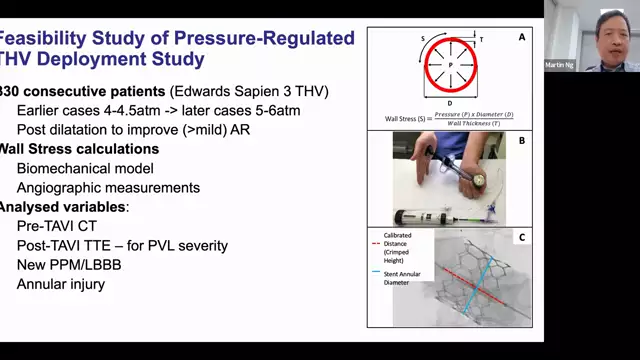Dr. Martin Ng, MD- Novel Pressure-Regulated Deployment Strategy for Improving the Safety & Efficacy of Balloon-Expand...
Professor Ng earned a first-class honours degree in medicine from the University of Sydney before going on to study the molecular biology of early coronary artery disease for his PhD. He went on to Stanford University Medical Center to complete his fellowship program. His study has won various prizes and accolades, including the Young Investigator of the Year award from the Royal Australasian College of Physicians. In this video Professor Ng discusses Novel Pressure-Regulated Deployment Strategy for Improving the Safety and Efficacy of Balloon-Expandable Transcatheter Aortic Valves.
Link to Abstract:
https://www.jacc.org/doi/10.1016/j.jcin.2021.08.037
Abstract:
Abstract \sObjectives
The authors propose a new pressure-controlled approach for balloon-expandable transcatheter heart valve (THV) deployment, with the goal of maximizing prosthesis-annulus apposition while minimizing tissue harm.
Background
The best way to deploy balloon-expandable THV is still up for dispute. Current techniques are volume-dependent, relying on the deployment apparatus being under- or overfilled. The maximum THV diameter and balloon pressure (Laplace's law) define the annular wall tension exerted by the expanding prosthesis during deployment.
Methods
A total of 330 patients with severe native aortic stenosis who received TAVR with SAPIEN 3 THVs were included in the study. Sixty-six patients were deemed to be at high risk of annular rupture. The THVs were deployed until a predetermined balloon pressure was reached. To minimize mild or severe angiographic paravalvular regurgitation, postdilatation was used (PVR). Annular wall stress was calculated using a biomechanical model for each instance and compared to rates of postdilatation, mild or greater PVR on transthoracic echocardiography, new permanent pacemaker installation or left bundle branch block, and annular rupture.
Results
Postdilatation rate (P 0.001) and ultimate PVR (P = 0.014) were lower in patients with wall stress more than 3 MPa. Annular rupture occurred in two of three high-risk patients with wall stress greater than 3.5 MPa (3.69 and 3.84 MPa), but not in 95 high-risk patients with wall stress less than 3.5 MPa. To assure deployment within target wall stress levels of 3 to 3.5 MPa, we selected a single target deployment pressure per THV size: 6.25 atm for 23-mm THVs, 5.5 atm for 26-mm THVs, and 5 atm for 29-mm THVs. There was a 10.0 percent postdilatation rate, 12.7 percent mild PVR, and no moderate to severe PVR in patients in this target range (n = 136). There was no consistent link between balloon filling volume, related pressure, and wall stress.
Conclusions
Regardless of high-risk anatomical complexities, pressure-regulated THV deployment is a straightforward, reproducible, safe, and effective approach.




